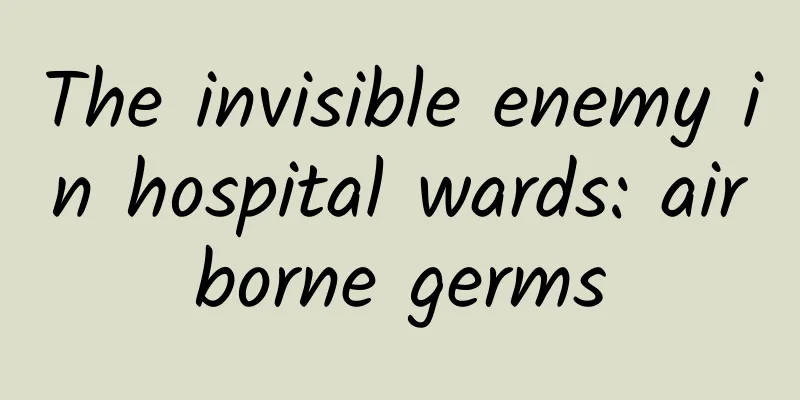The invisible enemy in hospital wards: airborne germs

|
Air pollution in hospital wards has become an "invisible enemy" in the hospital environment. It is transmitted through microorganisms such as bacteria and viruses in the air and enters the body, which may cause a series of health problems. This article will discuss the sources of air pollution in hospital wards, the harm to the body, and how to effectively prevent airborne pathogens. The "invisible enemy" in the air of the ward In hospital wards, germs in the air are often overlooked. Germs spread through the air and may cause respiratory infections, wound infections, etc. Hospitalized patients usually have weak immunity, and germs in the air can aggravate their condition. Coughing, sneezing and other behaviors spread a large number of bacteria and viruses into the air, especially some highly contagious diseases such as influenza and pneumonia, which are easily spread through the air. In addition, if the hospital's air conditioning system and ventilation equipment are not cleaned and disinfected in time, they will also become channels for the spread of germs. These devices will bring bacteria and viruses in the air to different corners of the ward, increasing the risk of germ transmission. Airborne pathogens and their hazards Common pathogens in the air include bacteria, viruses and fungi, which are transmitted to the human respiratory tract through tiny particles in the air. Once entering the body, the germs may colonize in the upper respiratory tract or lungs, causing infection. Common pathogens include influenza virus, Streptococcus pneumoniae, Mycobacterium tuberculosis, etc. For hospitalized patients with low immunity, airborne germs are more likely to cause infection, with symptoms including coughing, expectoration, fever, etc. If the infection is not treated in time, it may develop into pneumonia or severe respiratory infection, and even endanger life. In addition, airborne germs may also cause wound infection, especially for postoperative patients. If the wound is contaminated by airborne bacteria, it may cause infection or sepsis. Sources of air pollution There are many sources of air pollution in wards. First, the patient's coughing, sneezing, talking and other behaviors will release germs into the air, and other patients can be easily infected. Second, if the hospital beds, sheets, bedding and other items are not cleaned and disinfected in time, they will become a breeding ground for germs and then spread through the air. In addition, the hospital's ventilation equipment and air conditioning systems may also become channels for the spread of germs. Pathogens in the air may be dispersed to every corner of the ward through these devices, increasing the risk of germ transmission. If these devices are not cleaned and disinfected, the risk of air pollution in the ward will be greatly increased. How to effectively prevent germs in the air? In order to reduce the risk of airborne pathogens during hospitalization, hospitals need to take a series of measures to ensure air quality. First, the air conditioning and ventilation systems in the wards need to be cleaned and disinfected regularly to ensure that these devices do not become "transit stations" for the spread of pathogens. Hospitals should regularly inspect and maintain these devices, keep the air flowing, and take effective filtering measures to reduce harmful substances in the air. Secondly, hospitals should strengthen the cleaning and disinfection of wards, especially items that often come into contact with patients, such as bed sheets, quilts, pillows, and beds. All items in the ward should be replaced and disinfected regularly to prevent germs from growing and spreading on these items. For patients who need long-term hospitalization, they can ask the hospital to provide more replacement bed sheets, clothing, etc. to ensure a clean environment. Patients and their families also need to be vigilant and take certain preventive measures during hospitalization. First of all, patients can wear masks to reduce the inhalation of airborne germs. Masks can effectively filter bacteria and viruses in the air and protect patients from respiratory infections. Especially for patients with respiratory problems or poor immunity, wearing masks is an effective way to reduce infection. Family members should also pay attention to hygiene habits when visiting. Family members can disinfect their hands and wear masks before entering the ward, and try to avoid direct contact with other patients to reduce the chance of transmission of airborne germs. Family members should also keep their distance in the waiting area outside the ward, avoid getting too close to other patients and family members, and minimize the risk of cross-infection. In addition, patients should maintain good personal hygiene and try to avoid excessive coughing, sneezing, etc. in the ward. For patients with respiratory symptoms, appropriate isolation measures should be taken to reduce the spread of germs to others through the air. Summarize Airborne germs, as a health hazard that cannot be ignored during hospitalization, may affect the patient's recovery process. Hospitals need to strengthen the management of air quality in wards, regularly clean and disinfect air conditioning systems, ventilation equipment and items in wards to ensure fresh and safe air. Patients and their families should also enhance their awareness of protection and reduce the risk of airborne germs through simple and effective measures such as wearing masks and maintaining personal hygiene. Through these detailed preventive measures, we can provide patients with a safer and healthier treatment environment and promote their early recovery. Author: Chen Xiaoying, Lishui Second People's Hospital |
>>: Mom, wearing thermal underwear or not has nothing to do with chronic cold legs!
Recommend
Detailed explanation of the shape of female pubic hair, if you are interested, please read it
People are full of curiosity about the secrets of...
Can I eat potato chips during my period?
Potato chips are often eaten in our daily life, a...
What does a breast mass mean?
In recent years, breast diseases have seriously t...
What causes chest nodules?
Chest nodules, also known as breast nodules, are ...
Is a positive cervical cancer screening result a sign of cancer?
A positive cervical cancer screening is a symptom...
Black stool after miscarriage
Normally, our stool should be slightly yellow. Oc...
What are the symptoms of moderate breast hyperplasia?
Moderate breast hyperplasia is a serious stage of...
Is it normal to bleed after a tct?
Female friends should have regular gynecological ...
What to do if a girl's menstruation does not come
Menstruation is a physiological phenomenon that o...
What are the ways to make your private parts pink?
As they grow older, women can observe some change...
Knee bone rehabilitation, say goodbye to the pain of knee joint "clicking"
Author: Yao Linming, deputy chief physician of th...
How to regulate endocrine disorders and scanty menstruation
Endocrine imbalance often causes many problems, s...
Why does the pregnant woman have pain on the right side of her abdomen?
Women all know that abdominal pain during pregnan...
Will my belly get bigger at 6 weeks of pregnancy?
The symptom of a big belly in the 6th week of pre...
What to eat after abortion to enlarge breasts
The size of a woman's breasts is related to m...









